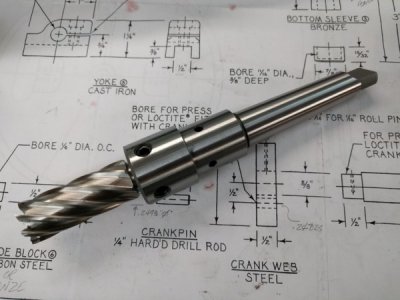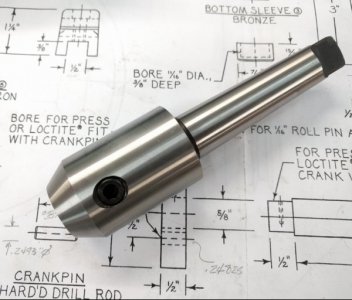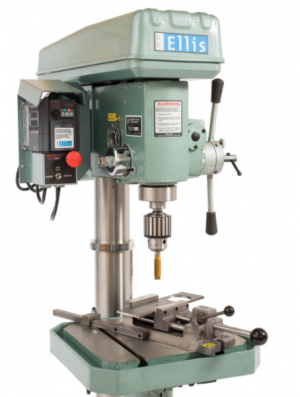-
Welcome back Guest! Did you know you can mentor other members here at H-M? If not, please check out our Relaunch of Hobby Machinist Mentoring Program!
You are using an out of date browser. It may not display this or other websites correctly.
You should upgrade or use an alternative browser.
You should upgrade or use an alternative browser.
MT3 to 3/4" Weldon
- Thread starter bobloblaw
- Start date
- Joined
- Sep 25, 2014
- Messages
- 1,152
Welcome to HM.
Buy it from a tool supplier? It depends on what you are using it for and on your drill press. You should be using a securing bolt in the back of the MT3 (since an end mill will want to pull down, the MT3 needs to be secured). However, most drill presses are not set up with a through bolt.
If your drill press is set up with a through bolt, then you are set - just purchase an MT3 adapter for Weldon shank tooling (with the back end thread to match your draw bar).
There are probably many suppliers. cdcotools dot com has them MT3 to 3/4" Weldon with a 1/2-13 thread for the drawbar - listed at $18US
Buy it from a tool supplier? It depends on what you are using it for and on your drill press. You should be using a securing bolt in the back of the MT3 (since an end mill will want to pull down, the MT3 needs to be secured). However, most drill presses are not set up with a through bolt.
If your drill press is set up with a through bolt, then you are set - just purchase an MT3 adapter for Weldon shank tooling (with the back end thread to match your draw bar).
There are probably many suppliers. cdcotools dot com has them MT3 to 3/4" Weldon with a 1/2-13 thread for the drawbar - listed at $18US
Last edited:
A
Alan H.
Forum Guest
Register Today
As David said, you buy yourself an MT3 to 3/4" Weldon adapter.
Not sure what your application is. When I bought one, I had in mind using annular cutters in my lathe and my drill press in mind. Both have MT3's, tailstock and quill respectively.
I have a set of annular cutters that I use in both the lathe and the drill press. Here's a Weldon holder with a 1" cutter in it. Notice it uses two set screws to assure the torque is managed and it is also equipped with a spring backed disc in it to manage the pilot pin of a annular cutter as well. The annular cutters have two flats on the shank. As I remember I bought this one via Amazon.

Another option is a MT3 end mill holder. This is like the CDCO example David mentioned. It has one set screw instead of two. As I understand it, these are really intended for end mills. I believe I got this one from Arceurotrade but don't really remember. By the way, my buddy @mksj mentioned the other day that these are called Side Lock Holders in the UK. Here's one from Amazon.

My luck with CDCO was not the best but some folks are very happy with them.
Not sure what your application is. When I bought one, I had in mind using annular cutters in my lathe and my drill press in mind. Both have MT3's, tailstock and quill respectively.
I have a set of annular cutters that I use in both the lathe and the drill press. Here's a Weldon holder with a 1" cutter in it. Notice it uses two set screws to assure the torque is managed and it is also equipped with a spring backed disc in it to manage the pilot pin of a annular cutter as well. The annular cutters have two flats on the shank. As I remember I bought this one via Amazon.

Another option is a MT3 end mill holder. This is like the CDCO example David mentioned. It has one set screw instead of two. As I understand it, these are really intended for end mills. I believe I got this one from Arceurotrade but don't really remember. By the way, my buddy @mksj mentioned the other day that these are called Side Lock Holders in the UK. Here's one from Amazon.

My luck with CDCO was not the best but some folks are very happy with them.
A
Alan H.
Forum Guest
Register Today
Bob, I don't think you need a securing bolt (drawbar). I do not believe most drill presses use drawbars.
For example my bigger drill press has a MT3 quill and it does not use a drawbar. You simply press the MT3 arbor into the quill using the downfeed lever and the MT arbor sticks. That is the beauty of a morse taper and if you put axial pressure on it drilling, it adheres even more. Trick is to keep it clean. To get the MT3 arbor out, there is a slot on the quill and you drive a wedge through to remove it.
So I think you are fine. BTW, the photos of the holders I have show that neither have provisions for a drawbar.

For example my bigger drill press has a MT3 quill and it does not use a drawbar. You simply press the MT3 arbor into the quill using the downfeed lever and the MT arbor sticks. That is the beauty of a morse taper and if you put axial pressure on it drilling, it adheres even more. Trick is to keep it clean. To get the MT3 arbor out, there is a slot on the quill and you drive a wedge through to remove it.
So I think you are fine. BTW, the photos of the holders I have show that neither have provisions for a drawbar.

Last edited by a moderator:
- Joined
- Sep 25, 2014
- Messages
- 1,152
Bob, Alan is right, you don't need a draw bar if you are using the drill press for drilling, or with the annular cutter. That is the kind of work that a drill press is designed for - so it is unusual for a drill press to have a draw bar.
You have not said what your intended use is.
You have not said what your intended use is.
- Joined
- May 16, 2016
- Messages
- 1,704
With drilling you only have rotational torque and down feed as the two main forces to deal with, A standard drill quill and MT handles these quite well. However when milling, with the exception of plunge cutting, much like drilling, you also have side force from the long or cross feed, this combined with the spiral flutes on the mill will pull the MT out of the socket. Not only will your cut get deeper you will most likely wreck the MT and socket and possibly break the cutter.
Unfortunatly most small drill presses don't have a hole down through the quill to fit a draw bar, but it's just as well because these machines also don't have the rigidity or suitable bearings in the quill to be used for milling.
However some heavier machines, sometimes known as Mill/ Drills, do have a hole for a draw bar and suitable bearings for light milling.
Many years ago I did see a device that a guy had made, where he had drilled a hole crossways through the tang and made two small blocks that fitted into the slot of the quill, they were drilled and one was tapped,
A special bolt was made with a taper on it, such that when it was fed through the blocks and the tang, then as it was tightened the taper drew the tang up tight and locked it in.
It worked but it was only for very light cuts, but it was good enough to make a few keyways etc. The process was still limited by the inadequate quill bearings.
Unfortunatly most small drill presses don't have a hole down through the quill to fit a draw bar, but it's just as well because these machines also don't have the rigidity or suitable bearings in the quill to be used for milling.
However some heavier machines, sometimes known as Mill/ Drills, do have a hole for a draw bar and suitable bearings for light milling.
Many years ago I did see a device that a guy had made, where he had drilled a hole crossways through the tang and made two small blocks that fitted into the slot of the quill, they were drilled and one was tapped,
A special bolt was made with a taper on it, such that when it was fed through the blocks and the tang, then as it was tightened the taper drew the tang up tight and locked it in.
It worked but it was only for very light cuts, but it was good enough to make a few keyways etc. The process was still limited by the inadequate quill bearings.
